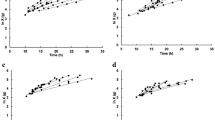Summary
In previous papers it was shown that the bacterium Zymomonas mobilis might be an interesting alternative for industrial alcohol production from sugar, compared to Saccharomyces bayanus. Factors that might increase the glucose to ethanol conversion efficiency and which are in favour of the bacterium, are the production of less biomass and less by-products such as glycerol, succinic acid, butanediol, acetoin, and acetic acid. In order to reduce the synthesis of biomass three metabolic inhibitors were now studied: dinitrophenol, azide and arsenate. Their effects on the alcoholic fermentation in batch and in immobilized cell system were investigated, using three yeasts: Saccharomyces bayanus, Schizosacharomyces pombe, and Saccharomyces diastaticus. It was found that dinitrophenol in 0.1 mM concentration was effective in increasing the conversion of glucose to ethanol especially with Saccharomyces bayanus while azide in 0.1 mM concentration was better with Schizosaccharomyces pombe. In immobilized systems high steady state ethanol production from 15% glucose media was obtained by inclusion into the media of dinitrophenol or azide. Arsenate had less effect at the concentration used. Arsenate had less effect at the concentrations used. As a result ethanol productivity in g·l-1·h-1 was increased from around 70 in the absence of inhibitor to around 74 in the presence of dinitrophenol with Saccharomyces bayanus. With Schizosaccharomyces pombe the productivity was increased from around 65 in the absence of inhibitor to around 74 in the presence of azide. The specific ethanol productivity expressed as g ethanol formed per hour and per g viable cells was increased from 0.87 to 1.37 for Schizosaccharomyces pombe and from 1.02 to 1.66 for Saccharomyces bayanus.
Similar content being viewed by others
References
Amin G, Verachtert H (1982) Comparative study of ethanol production by immobilized cell systems using Z. mobilis and S. bayanus. Eur J Appl Microbiol Biotechnol 14:59
Amin G, Van den Eynde E, Verachtert H (1983) Determination of by-products formed during the ethanolic fermentation, using batch and immobilized cell systems of Z. mobilis and S. bayanus. Eur J Appl Microbiol Biotechnol 18: 1–5
Duro AF, Serrano R (1981) Inhibition of succinate production during yeast fermentation by de-energization of the plasma membrane. Current Microbiol 6: 111
Genevois L (1950) Balance studies on the alcoholic fermentation of yeast. Biochem Biophys Acta 4: 179
Grote M, Lee KL, Rogers PL (1980) Continuous ethanol production by immobilized cells of Z. mobilis. Biotechol Letters 2: 481
Hahn-Hagerdal B. Mattiasson B (1982a) Azide sterilization of fermentation media. Eur J Appl Microbiol Biotechnol 14: 140
Hahn-Hagerdal B, Mattiasson B (1982b) Shift in metabolism towards ethanol production in S. cerevisiae by addition of metabolic inhibitors. In: Scott CD (ed) Fourth symposium on biotechnology in energy production and conservation. Biotechnol Bioeng Symp12. John Wiley and Sons. New York, p 193
Herbert D, Phipps PJ, Strange RE (1971) The chemical analysis of cells. In: Norris JR, Ribbons DW, (eds) Methods in microbiology, vol 5B. Academic Press, London New York, p 209
Miller CL (1959) Use of dinitrosalicylic reagent for determination of reducing sugar. Anal Chem 31: 426
Oura E (1977) Reaction products of yeast fermentation. Process Biochem 12: 19
Pierse JS (1970) Analysis committee of yeast viability. J Inst Brew 76: 442
Postgate JR (1969) Viable counts and viability. In: Norris JR, Ribbons DW (eds) Methods in microbiology, vol 1. Academic Press, London New York, p 611
Rothstein A, Berke H (1952) Endogenous alcoholic fermentation in yeast induced by 2–4 dinitrophenol. Arch Biochem Biophys 36:195
Simon EW, Beavers H (1951) The quantitative relationship between pH and the activity of weak acids and bases in biological experiments. Science 144: 124
Trevelyan WE, Grammon JN, Wiggins EH, Harrison JS (1952) Yeast metabolism. II. Synthesis of cell carbohydrates during glucose fermentation and its inhibition by azide. Biochem J 50:303
Wada M, Kata J, Chibata I (1980) Continuous production of ethanol using immobilized growing yeast cells. Eur J Appl Microbiol Biotechnol 10: 275
Wang HY, Hettwer DJ (1982) Cell immobilization in k-carrageenan with tricalcium phosphate. Biotechnol Bioeng 24: 1827
Wlliams D, Munnecke DM (1981) The production of ethanol by immobilized yeast cells. Biotechnol Bioeng 23: 1813
Winzler RJ (1944) Azide inhibition of anaerobic assimilation of glucose by yeast and its application to the determination of fermentable sugar. Science 99: 327
Author information
Authors and Affiliations
Rights and permissions
About this article
Cite this article
Amin, G., Standaert, P. & Verachtert, H. Effects of metabolic inhibitors on the alcoholic fermentation by several yeasts in batch or in immobilized cell systems. Appl Microbiol Biotechnol 19, 91–99 (1984). https://doi.org/10.1007/BF00302447
Received:
Issue Date:
DOI: https://doi.org/10.1007/BF00302447




